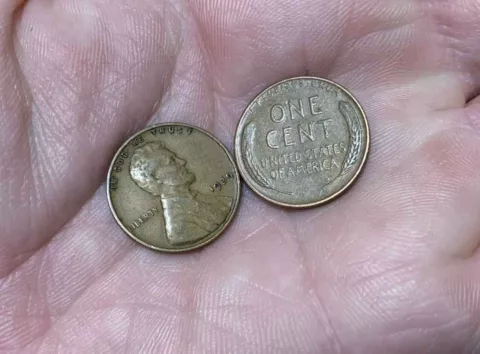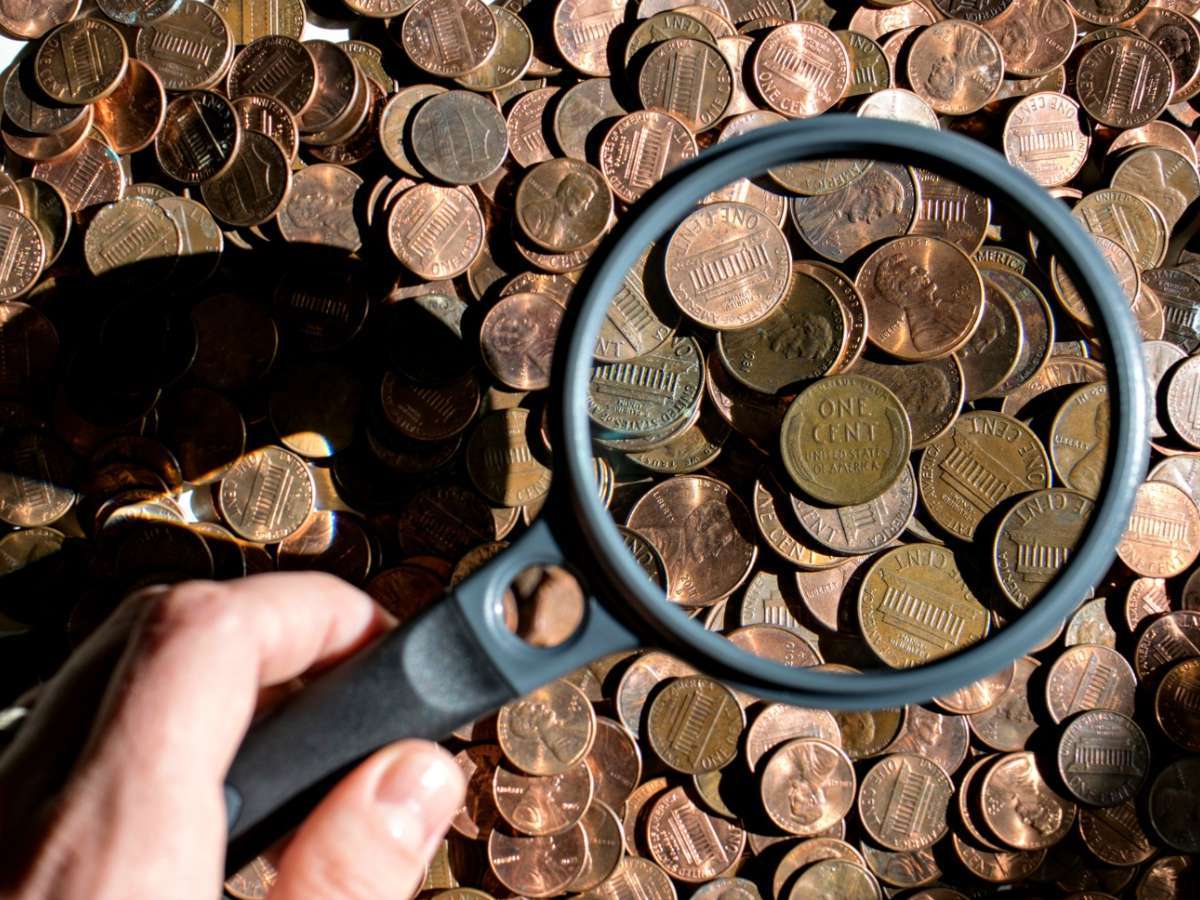
Do you have a 1939 penny and want to know what it’s worth?
I’ve come across many 1939 pennies over the years and found that some are worth quite a bit of money. In fact, some are worth thousands of dollars… for real!
To help you determine how much your 1939 wheat penny is worth, follow along as I reveal:
- How to tell the difference between a rare 1939 wheat penny that’s quite valuable and common 1939 pennies that are worth only a few cents
- How much all 1939 Lincoln wheat cents are worth
- A list of 1939 pennies you should be looking for in your pocket change
- The most popular 1939 penny errors and varieties you could actually find in your spare change
Okay, now let’s see how much your 1939 Lincoln wheat cent is worth…
How Much Is A 1939 Penny Worth?
How much your 1939 wheat penny is worth depends mostly on these 3 things:
- The mintmark on your coin (or absence of one)
- Your coin’s condition (or state or preservation)
- Any errors (or varieties) that might be evident on your coin
Those are the 3 factors that play the biggest role when determining any coin’s value — and it’s especially true with old wheat pennies.
Wheat pennies are very popular with coin collectors. Those that are in excellent condition and/or have errors or varieties are worth much more than a “typical” wheat penny!
Also, mint marks (or the lack of one) indicate which United States Mint facility struck the coin — which can tell you how scarce your coin is. Some 1939 pennies are much less common than others, depending on where they were minted.
1939 Wheat Penny Value (no mintmark)
The most common 1939 Lincoln cent is the kind struck at the Philadelphia Mint. On these Philly-minted wheat pennies you won’t find any mintmark (that little letter you see under the date on some Lincoln cents). The Philadelphia Mint struck a total of 316,466,000 pennies in 1939 — and a great many of these are still around.
Well-worn 1939 Philly-minted pennies are worth 5 cents to 10 cents, while examples in unworn, or uncirculated, condition can usually fetch $1 or more. The record price for a 1939 wheat penny is the $9,775 paid in 2006 for an MS-68 Red specimen graded by Professional Coin Grading Service (PCGS).
1939-D Penny Value (“D” mintmark)
The scarcest type of circulating 1939 pennies are those made at the Denver Mint. These have a little “D” under the date and are much harder to find in circulation. Only 15,160,000 were struck — which is just a fraction of the number struck in Philadelphia in 1939.
Still, 1939-D wheat pennies are common enough, and the typical 1939-D penny is worth about 25 cents to $1 in circulated condition. On the other hand, uncirculated specimens are worth about $2.75 and up. The record for the most valuable 1939-D penny ever sold goes to one PCGS-graded MS-68 Red specimen that sold for $11,500 in 2009! Now, there’s a pretty penny, am I right?
1939-S Penny Value (“S” mintmark)
While not as scarce as its 1939-D counterpart, the 1939-S penny is much scarcer than the Philly-mint pieces of 1939. A total of 52,070,000 were struck at the San Francisco Mint in 1939 bearing the “S” mintmark.
Values range from about 15 cents to 90 cents in typical worn grades, while uncirculated pieces go for $1.50 or more. The most valuable 1939-S penny ever sold was graded MS-67+ by PCGS and realized $3,966 in 2013.
1939 Proof Penny Value
Made for coin collectors, the 1939 proof Lincoln wheat cent was struck by specially prepared dies on highly polished planchets (coin blanks). A total of 13,520 were made at the Philadelphia Mint. A 1939 proof penny is usually worth between $35 and $100.
However, one super-nice specimen graded MS-66 Cameo by Numismatic Guaranty Corporation (NGC) and featuring frosty design details and lettering commanded $4,025 in 2010.
A List Of Rare 1939 Penny Errors & Varieties
Errors and varieties can be tricky for some coin collectors to accurately spot.
The truth is, most of the photos I’ve seen of coins that their owners believe have a valuable error or variety are unfortunately just post-mint damage or alterations. For example… coins with holes, weird scratches, and bends are various forms of damaged and altered coins that people commonly find in their pocket change.
That said, these are some of the 1939 wheat penny errors you should be looking for:
1939 Doubled Die Pennies
Doubled die errors are created when the hub, which imprints a design onto the working die, imprints the design twice upon the die and at two slightly different angles. The doubled image on the die is then struck onto every coin the die creates. In some cases the die isn’t replaced until its old and worn out. However, often a mint employee recognizes the error, removes the die, and destroys any doubled die coins he or she can find. In all cases, doubled die coins are scarce and highly collectible.
There are several known doubled dies among 1939 Lincoln wheat cents, including:
- 1939 Philadelphia doubled die — One major variety shows doubling on the obverse in the lettering LIBERTY and in the date. Market information on this coin is spotty, but similar pieces trade for $25 or more.
- 1939-S doubled die — A few 1939-S doubled die cents exhibit doubling in the eyelid. Pieces like this can fetch $10 or more.
1939 Pennies With BIE Varieties & Other Die Breaks
A die break occurs when an aging die begins to shows signs of extreme wear and tear. Die cracks present themselves as raised lines on the struck coin. The value and collectability of such a coin depends on the size of the crack and its location.
One of the most popular types of die cracks is one that commonly forms between the B and E of LIBERTY on the obverse of the coin, just to the left of Lincoln. These are known as so-called BIE varieties because the small, vertical die crack takes the form of a capital letter I. BIE varieties are typically worth $5 to $10.
1939 Off-Center Pennies
Off-center strikes occur when either the die is misaligned or a coin is struck outside of its retaining collar.
The value of an off-center strike depends on how drastic the error is and the visibility of the date.
The most valuable types of off-center errors are those in which the coin is severely off square and yet the date is still fully visible.
Most 1939 off-center pennies that are, say, 10% to 20% off center, are worth around $25. However, pieces exhibiting 50% or more off-center variation have a value of $75 to $100 or more.
1939 Pennies With Repunched Mintmarks
In the 1930s, the mintmark was individually hand-punched onto each working die.
This opened up many opportunities for cases in which the stamp would be punched not just once but multiple times and at various angles or in different places.
There are thousands of known varieties involving repunched mintmarks across all Lincoln cents, including some among the 1939 pennies.
Most are worth $3 to $5 apiece.
1939 Pennies With Clipped Planchets
Sometimes coins are incorrectly punched out of the long, thin metal strips from which the blanks derive.
These clipped planchet errors present as straight, sometimes crescent-shaped cuts going into the coin.
If you find a 1939 penny with a clip, be sure to hang on to it!
Clipped planchets are neat errors that are worth anywhere from $10 to $25 apiece.
1939 Counterstamped Pennies
A lot of collectors report old pennies that have odd letters or unusual designs on them. Most of these are counterstamps, which are a type of post-mint alteration.
Many counterstamped pieces were once repurposed as tokens, coupons, or other merchandising pieces produced by private businesses.
These coins are known by many as novelty coins and they belong to the realm of exonumia.
There are many collectors who love these counterstamped coins and enthusiastically collect them.
Many 1939 Lincoln cents with counterstamps are collectible — and such pieces are worth about $1 and up.
IMPORTANT: What Is The Grade Of Your 1939 Penny?
To determine the true value of your 1939 wheat penny, you first need to know what condition (or grade) your coin is in.
Grab a coin magnifier and a copy of the U.S. Coin Grading Standards book. Then, watch this video to see how to grade coins yourself at home:




